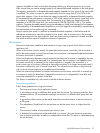
Fibre Channel switches typically offer two types of frame routing between N_Ports:
• Source ID/Destination ID (SID/DID) routing, which transfers all exchanges through the fabric
using the same path
• Exchange-based routing, which transfers all frames within an exchange using the same path,
but other exchanges may use alternate paths
NOTE: B-class switches refer to SID/DID protocol as in-order delivery routing. C-class switches
refer to SID/DID protocol as flow-based load balancing . Both switch classes use exchange-based
routing terminology. See the individual switch user guides for configuration details.
The current HP FC Data Replication Protocol (HP-FC) uses multiple exchanges for each data
replication transfer. One or more exchanges are used to transfer data and an additional exchange
is used for command information. The HP-FC Protocol requires all frames within the transfer to be
delivered in order. Therefore, if HP-FC Protocol is used in the fabric, the fabric must use SID/DID
routing.
HP SCSI FC-Compliant Data Replication Protocol (HP SCSI-FC) was developed to take advantage
of the exchange-based routing protocol available in fabric switches. HP SCSI-FC and HP-FC
protocols are available on controller software versions later than 0952xxxx; earlier versions support
only the FC-HP Protocol.
The three options listed in Figure 6 (page 43) are as follows:
• HP FC Data Replication Protocol. This protocol requires all transfers to be completed in order,
which is accomplished by the proper configuration of the SAN fabric switches for SID/DID.
See the HP P6000 Continuous Access Implementation Guide for specific settings and the
appropriate switch user guides for detailed instructions.
An array configured for this protocol successfully creates a DR group only with an array
capable of HP-FC, which is the default protocol for controller software versions 0952xxxx and
earlier, and is user-selectable in later versions. Fabric misconfiguration with this protocol
selection results in significant performance degradation and possible data integrity issues on
the destination array.
• HP SCSI FCP Compliant Data Replication Protocol. This protocol supports the transfer of EVA
data replication traffic in a fabric configured for exchange-based or SID/DID routing. The
protocol can take advantage of the exchange-based fabric setting, but is not dependent on
the fabric setting. For the proper configuration of the SAN fabric switches for Exchange, see
the HP P6000 Continuous Access Implementation Guide; for specific settings, see the
appropriate switch user guides for detailed instructions.
• Either. This selection should be used when the SAN contains arrays running both HP-FC and
HP SCSI-FC protocols. The Either selection allows arrays only capable of HP-FC to successfully
create DR groups with the arrays running controller software version later than 0952xxxx.
This facilitates the migration of data from older to newer arrays. The HP-FC protocol is
dependent on the fabric configuration being set for SID/DID routing. The same fabric
considerations noted in the HP-FC option apply to the Either selection as well.
44 Replicating storage


















